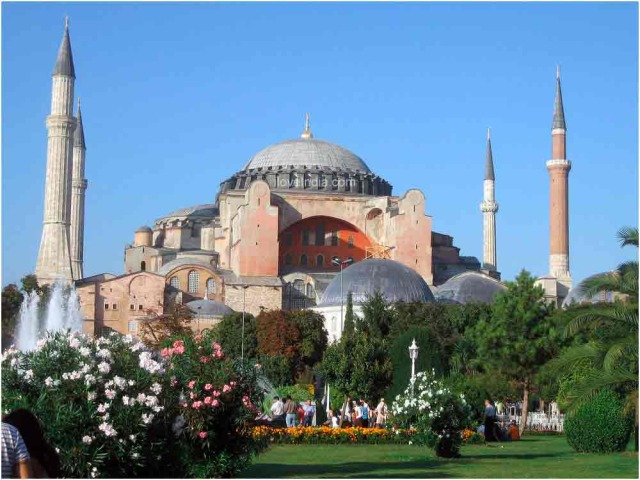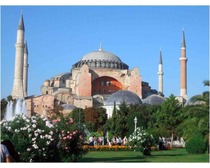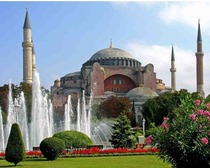A former Byzantine church and a mosque, Hagia Sophia is situated in Istanbul, Turkey. Check out some more interesting and fun facts about Hagia Sophia.
Hagia Sophia Facts
A former Byzantine church and a mosque, The Church of the Holy Wisdom is known as 'Hagia Sophia' in Greek, 'Saint Sophia' in Latin and 'Ayasofya' or 'Aya Sofya' in Turkish. Hagia Sophia has a trail that dates back to 532-537 AD. The monument is unique in its existence - having a base of both Christianity and Islam. Hagia Sophia, both architecturally and liturgically, was influenced by Eastern Orthodox, Roman Catholic and Muslim worlds. Explore some interesting and fun facts about Hagia Sophia

Interesting And Fun Facts About Hagia Sophia
- Hagia Sophia, an ex- patriarchal basilica and mosque, is currently serving as a museum in Istanbul, Turkey.
- The monument is considered the epitome of Byzantine architecture, because of its enormous dome.
- Hagia Sophia remained the largest cathedral in the world for a span of thousand years, until the construction of Medieval Seville Cathedral in 1520.
- The existing structure dates back to 532-537 AD. It was built on the instruction of the Byzantine Emperor Justinian.
- Hagia Sophia was third Church of the Holy Wisdom to occupy the site. The earlier two were destroyed during riots.
- Isidore of Miletus and Anthemius of Tralles were the designers of the monument.
- Hagia Sophia has an anthology of holy relics. A 50 foot silver iconostasis is amongst the several sacred remnants in the museum today.
- For 1000 years, the monument served as the patriarchal church of the Patriarch of Constantinople and the focal point of the Eastern Orthodox Church.
- It was in 1453 that Constantinople was conquered by the Ottoman Turks. Following this, Sultan Mehmed II ordered the building to be changed into the Ayasofya Mosque.
- The transformation of the church into a mosque caused the removal of bells, altar, iconostasis, and sacrificial vessels. Eventually, many mosaics were plastered over again.
- Under the rule of the Ottomans, Hagia Sophia attained Islamic features, such as the mihrab, the minbar, and the four minarets outside.
- Hagia Sophia remained the principal mosque of Istanbul for about 500 years.
- The mosque served as a inspiration for the construction the Ottoman mosques, such as Sultan Ahmed Mosque or Blue Mosque of Istanbul, ªehzade Mosque, Süleymaniye Mosque, and Rüstem Pasha Mosque.
- It was in 1935 that the first Turkish President - Mustafa Kemal Atatürk, converted the mosque into a museum.
- Hagia Sophia is also referred to as 'Saint Sophia', which means wisdom in Greek. The full name of Hagia Sophia is Church of the Holy Wisdom of God. The church was dedicated to the Holy Wisdom of God, rather than a specific saint named Sophia.
- Originally, Hagia Sophia was named Megale Ekklesia or the Great Church.
- The monument is universally acknowledged as one of the great buildings of the world.
- The structure of Hagia Sophia has a classic basilica plan. The main ground plan consists of a rectangle, 230 feet in width and 246 feet in length. The area is covered by a central dome with a diameter of 31 meters, slightly smaller than that of the Pantheon in Rome.
- Hagia Sophia has the ultimate contrast of two religions together. Both Islam and Christianity have their foothold in museum. While the Islamic calligraphic roundels are suspended from the main dome, the museum also has uncovered Christian mosaics as its prime feature.
- In his book De caerimoniis aulae Byzantinae (Book of Ceremonies), Emperor Constantine VII wrote about all the details of the ceremonies held in the Hagia Sophia.
- Hagia Sophia has forty windows around the base of the dome. It is famous for the mystical quality of light that reflects everywhere in the interior of the nave.
- When the dome was placed atop Hagia Sophia, its weight caused the walls to lean outward, because of the wet mortar underneath. In order to rebuild the dome, Isidore had first build up the interior of the walls, so that they were vertical and supported the weight of the new dome.
- The height of the present dome is also approximately twenty feet more than the original structure.
- The dome of Hagia Sophia is shaped like a scalloped shell or the inside of an umbrella, with ribs that extend from its top, down to its base.
- The unique character of the design of Hagia Sophia shows how it is one of the most advanced and ambitious monuments of late antiquity.


See also
More from iloveindia.com
- Home Remedies | Ayurveda | Vastu | Yoga | Feng Shui | Tattoos | Fitness | Garden | Nutrition | Parenting | Bikes | Cars | Baby Care | Indian Weddings | Festivals | Party ideas | Horoscope 2015 | Pets | Finance | Figures of Speech | Hotels in India : Delhi | Hyderabad | Chennai | Mumbai | Kolkata | Bangalore | Ahmedabad | Jaipur
- Contact Us Careers Disclaimer Privacy Policy Advertise With Us Lifestyle Sitemap Copyright iloveindia.com. All Rights Reserved.







